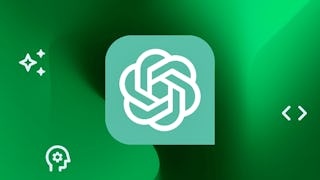Imagine designing databases that evolve with your business, anticipate future needs, and solve problems you haven't even encountered yet. This course teaches you to use AI as your intelligent design partner—creating database architectures neither human nor AI could achieve alone. You'll master AI-powered design techniques that transform traditional database development, leveraging generative AI for schema simulation, automated gap analysis, and AI-facilitated requirement discovery. Together with your AI collaborator, you'll craft schemas that reduce technical debt, minimize migrations, and maintain peak performance through AI-optimized design choices.


您将学到什么
Have AI interview you with intelligent questions to uncover critical data insights and identify database design blind spots
Use AI to simulate database designs before implementation to identify performance issues, better designs, and additional data needs
Brainstorm and generate complete dashboard and reporting implementations on top of your database in seconds without programming
您将获得的技能
要了解的详细信息

添加到您的领英档案
2 项作业
了解顶级公司的员工如何掌握热门技能

积累特定领域的专业知识
- 向行业专家学习新概念
- 获得对主题或工具的基础理解
- 通过实践项目培养工作相关技能
- 获得可共享的职业证书

该课程共有4个模块
This module introduces you to transformative techniques for using AI as a true design partner in database development, helping you create schemas that are more adaptable, robust, and aligned with business needs. Key Topics: Flipped Interaction Pattern: Having AI interview you about requirements to uncover critical insights SQL Implementation Generation: Creating complete, ready-to-use database schema scripts from conversations Database Schema Visualization: Converting requirements into entity-relationship diagrams and visual models Cross-Database Targeting: Generating implementation SQL for different database systems (MySQL, PostgreSQL, etc.) Design Package Creation: Building reusable archives that capture design context and reasoning Bootstrapping Conversations: Ensuring AI fully understands your schema in new design sessions Learning Outcomes: By the end of this module, students will be able to: Use the flipped interaction pattern to have AI ask you questions about requirements Generate complete SQL implementation scripts for your database design Create entity-relationship diagrams and visualizations from conversations Retarget schemas across different database platforms with minimal effort Transform conversations into comprehensive design packages with SQL implementation Bootstrap new conversations by having AI analyze existing schemas Verify AI's understanding of database structure before proceeding This module teaches a fundamentally new approach to database design. Rather than starting with a blank page, you'll learn to engage AI in thoughtful conversation about your data needs. Students will discover how to have the AI interview them about requirements, generate SQL schemas, and create multiple artifacts that capture both the implementation code and the reasoning behind design decisions. The techniques you'll learn aren't just about working faster—they're about thinking more deeply about your database design while still producing concrete SQL implementation that can be immediately deployed. You'll learn how to rapidly move from conceptual design to physical implementation across different database platforms, all while maintaining complete documentation of the design process.
涵盖的内容
3个视频3篇阅读材料1个作业
This module explores how to leverage AI to dramatically accelerate the database design lifecycle through iterative prototyping, simulation, and testing—all before writing a single line of implementation code. Key Topics: Database Persona Simulation: Teaching AI to act as your database and execute queries against schemas that don't exist yet Gap Analysis: Identifying what questions your database design can't answer efficiently Multiple Design Exploration: Generating and evaluating competing database architectures simultaneously Load Testing Simulation: Predicting performance bottlenecks under various usage scenarios Schema Resilience Testing: Validating designs against unexpected query patterns Conversational Design Refinement: Using targeted AI questioning to iteratively improve schemas Design Package Evolution: Creating comprehensive design artifacts that capture reasoning and refinement history Learning Outcomes: By the end of this module, students will be able to: Simulate database query execution against unimplemented schemas Identify design limitations and gaps through AI-powered analysis Rapidly iterate through multiple schema variations to find optimal solutions Test schema performance characteristics without implementation Generate realistic test queries that challenge design assumptions Create documentation that captures the evolution of design thinking This module transforms database design from a slow, implementation-heavy process into a rapid, iterative conversation. Students will learn to catch design flaws early, explore exponentially more design options, and arrive at higher quality schemas.
涵盖的内容
7个视频3篇阅读材料1个作业
This module focuses on transforming database designs into actionable insights through AI-powered dashboard and reporting tools. Students will learn how to rapidly prototype and implement visualization solutions that directly connect to their database designs. Key Topics: Rapid Dashboard Prototyping: Converting requirements into visual mockups and functional prototypes in minutes Database Performance Optimization: Identifying and resolving performance bottlenecks for reporting workloads Materialized Views & Summary Tables: Designing database structures specifically optimized for reporting Report-Driven Schema Evolution: Using reporting needs to refine underlying database designs Interactive Implementation: Generating functional Python visualization code that connects directly to databases Dashboard Package Creation: Building comprehensive, shareable dashboard solutions Learning Outcomes: By the end of this module, students will be able to: Generate complete Python dashboard implementations with minimal coding Identify database design limitations for reporting through AI-powered simulation Design database schemas optimized for both transaction processing and analytics Create interactive visualizations that effectively communicate database insights Develop a holistic approach to database and reporting design as interconnected systems This module bridges the gap between data storage and data insight, teaching students to think about databases not just as repositories of information, but as foundations for decision support systems.
涵盖的内容
3个视频3篇阅读材料
This module explores powerful techniques for using AI to transform existing data sources into optimized database designs and manage schema migrations when requirements change. Key Topics: Excel-to-Database Transformation: Converting spreadsheet collections into proper relational schemas Visual-to-Schema Design: Creating database designs from photographs or diagrams of real-world items Step-by-Step Migration Planning: Designing low-risk database schema changes when requirements evolve Schema Evolution Strategies: Balancing backward compatibility with new requirements Migration Risk Analysis: Identifying potential pitfalls in schema changes Data Preservation Planning: Ensuring existing data integrity during migrations Learning Outcomes: By the end of this module, students will be able to: Transform Excel spreadsheets and other existing data into optimized database schemas Generate complete SQL implementation scripts from non-database sources Design step-by-step migration plans for simple and complex schema changes Evaluate alternative migration approaches based on risk and business impact Create SQL scripts that safely migrate data while preserving functionality Design database schemas starting from photos, descriptions, or other non-traditional inputs This module teaches you to move beyond the blank-slate approach to database design. You'll learn to work with the raw materials you already have - whether that's Excel files, existing databases that need evolution, or even just photographs of real-world items you want to track. The techniques you'll master will help you handle one of the most challenging aspects of database management: safely evolving schemas when requirements change. You'll learn to have AI create detailed, step-by-step migration plans that minimize risk while enabling your database to adapt to new business needs.
涵盖的内容
2个视频3篇阅读材料
获得职业证书
将此证书添加到您的 LinkedIn 个人资料、简历或履历中。在社交媒体和绩效考核中分享。
位教师

从 Data Management 浏览更多内容
 状态:免费试用
状态:免费试用Vanderbilt University
 状态:免费试用
状态:免费试用Vanderbilt University
 状态:预览
状态:预览Northeastern University
人们为什么选择 Coursera 来帮助自己实现职业发展




学生评论
38 条评论
- 5 stars
85%
- 4 stars
12.50%
- 3 stars
0%
- 2 stars
0%
- 1 star
2.50%
显示 3/38 个
已于 Aug 4, 2025审阅
Excellent! Really enjoyed this course. As a DBA and data analyst, I can't wait to put these techniques into practice.
已于 Oct 8, 2025审阅
Excellent and relevant to present times!! I not only learnt a lot but also enjoyed the process!!
常见问题
Multiple Design Exploration with Generative AI - Generate and evaluate competing database designs simultaneously to select the optimal architecture
AI Database Simulation - Test queries against non-existent databases and get realistic results
Conversational Requirement Extraction with Generative AI - Have AI interview you to uncover hidden data needs
Rapid Design Iteration with AI - Refine database schemas in minutes instead of days based on AI-enhanced feedback
Performance Bottleneck Prediction with AI - Identify future performance issues before they happen
Intelligent Gap Analysis - Discover what questions your database can't answer—before implementation
Excel-to-Database Conversion with AI - Transform spreadsheet collections into proper relational schemas
Visual-to-Schema Transformation with Multimodal Prompting - Turn photographs or diagrams into optimized database structures
Synthetic Data Generation with AI - Create thousands of realistic test records with perfect relationships
Instant AI Dashboard Creation - Generate visualization code to validate reporting capabilities
AI-Powered Schema Evolution - Design databases that gracefully adapt to changing requirements
Automated Migration Planning with AI - Design step-by-step schema changes with minimal risk
AI-Enhanced Load Testing - Simulate database behavior under various usage patterns
Rapid Report Prototyping with AI Code Generation - Test business intelligence capabilities before implementation
Smart Schema Validation with AI Analysis - Identify inconsistencies and anti-patterns through AI collaboration
Robust Design Documentation Creation with AI - Build self-contained archives that preserve design context
Strategic Index Planning with AI - Design indexing strategies that balance read/write performance
Business-Aligned Database Design with AI - Create schemas that directly map to business objectives
Design Narrative Documentation with AI - Create documentation that explains the "why" behind design choices
Schema Resilience Testing with AI - Validate your design against unexpected usage patterns
Unlike traditional database design courses that focus solely on schema modeling and normalization, this course teaches a collaborative human-AI approach that dramatically expands what's possible. You'll learn to leverage generative AI as a design partner—simulating databases before implementation, testing queries against non-existent schemas, and exploring multiple competing designs simultaneously. Rather than just teaching database theory, we show you how to combine your domain expertise with AI's analytical capabilities to create more resilient, future-proof database architectures that neither could achieve alone.
You'll need access to a modern generative AI tool with conversation capabilities, such as ChatGPT, Claude, or similar large language models. The techniques we teach work across multiple platforms, though we provide specific examples using ChatGPT. The course doesn't require coding-specific AI tools or specialized database software beyond what you'd typically use for database work. Most exercises can be completed using the AI tool's web interface, though we'll talk about how to integrate with other tools for more advanced workflows.
更多问题
提供助学金,




